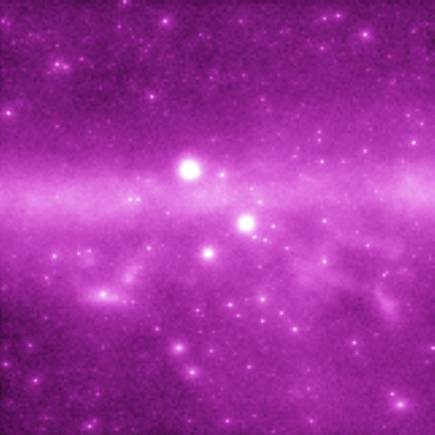GLAST Gamma Ray Sky Simulation

Explanation:
What shines in the gamma-ray sky?
This simulated image models the intensities
of
gamma rays
with over 40 million times the energy of visible light,
and represents how the sky might appear to the
Gamma-ray Large
Area Space Telescope (GLAST) after its first year in orbit.
Familiar steady stars are absent from
the dramatic 80x80 degree field which looks directly
away from the center of the Galaxy.
Instead,
the Geminga and
Crab pulsars - bizarre, spinning
stellar corpses known to be
neutron stars - are the two brightest
gamma-ray sources.
These and other gamma-ray bright objects in the field,
monstrous active galaxies and still
unknown sources, have been detected by the
Energetic
Gamma-Ray Experiment Telescope (EGRET) on the orbiting
Compton Gamma-Ray Observatory.
However, most of the simulated sources are new - extrapolating
current ideas and anticipating discoveries
resulting from GLAST's
improved gamma-ray vision.
The central broad band of faint gamma-ray emission is
due to high-energy
cosmic rays
colliding with interstellar gas in the outer spiral arms of
the Milky Way, while
below is a diffuse energetic glow from
prominent molecular clouds
in Monoceros, Orion, Auriga, and Taurus.
Intended to explore
extreme environments in
the distant cosmos
and planned for launch in 2005, GLAST is under development by
NASA, U.S., and international partners.
Authors & editors:
Robert Nemiroff
(MTU) &
Jerry Bonnell
(USRA)
NASA Web Site Statements, Warnings,
and Disclaimers
NASA Official: Jay Norris.
Specific
rights apply.
A service of:
LHEA at
NASA /
GSFC
& Michigan Tech. U.

